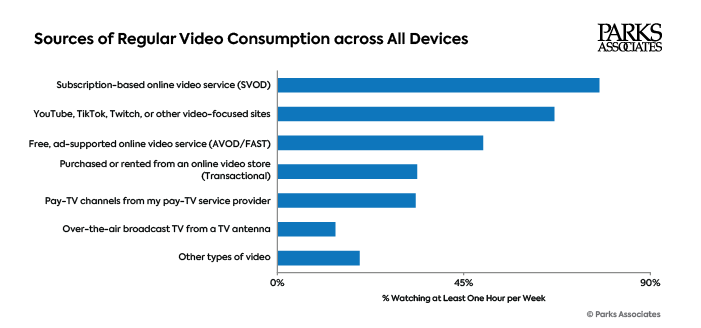Video Viewing Rises Significantly in U.S. Internet Households
Those homes are now watching six more hours of video per week than they were in 2020

U.S. Internet households now consume an average 43.5 hours of video per week across all viewing devices. That’s an increase of more than six hours in 2020, when the average was 37.2 hours, according to Parks Associates.
The new Parks research also found that 61% of these households watch paid streaming services on a TV set, consuming an average of 7.5 hours per week of content from these sources. Worth noting: 50% of people who consume video on a viewing device (TV, computer, tablet, or phone) watch a free, ad-supported service (FAST) or ad-based video on-demand service (AVOD) at least once a week.
This data was released during the 2024 NAB Show by Parks Associates in a new research report entitled, ‘The Viewer Journey: Navigating Streaming Options’. The study surveyed 8,000 consumers and 10,000 internet households to find out how viewers access video content across broadcast, traditional pay TV, and streaming video models, including SVOD, AVOD/FAST, TVOD, and vMVPD (streaming TV) services.
“Video-viewing households report watching on average more than 21 hours per week on a TV, accounting for half of their viewing hours,” said Sarah Lee, research analyst at Parks Associates. “Video consumption on a cell phone continues to rise—excluding social video sources, US internet households spend 6.5 hours per week watching video a smartphone and 3.9 hours on a tablet. TVs are still the main video-viewing device, but platform usage continues to diversify.”
The Viewer Journey lists paid streaming services as the most popular content type consumed across TV, mobile, computers, and tablets, but noted households watch several different types of services across their devices over the week. 78% of households report watching an SVOD service weekly, followed by 67% of households who watch user-generated content found onYouTube and other sources.
“The flexibility and convenience that on-demand services offer is highly appealing to viewers, but many households enjoy a balance between finding something to watch and watching what they find,” Lee said. “Given the popularity of FAST and user-generated content, consumers may soon decide they do not need to subscribe to as many services as they do now.”

Get the TV Tech Newsletter
The professional video industry's #1 source for news, trends and product and tech information. Sign up below.
James Careless is an award-winning journalist who has written for TV Technology since the 1990s. He has covered HDTV from the days of the six competing HDTV formats that led to the 1993 Grand Alliance, and onwards through ATSC 3.0 and OTT. He also writes for Radio World, along with other publications in aerospace, defense, public safety, streaming media, plus the amusement park industry for something different.

